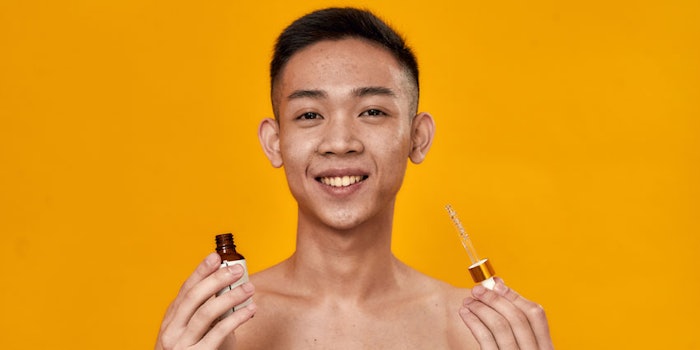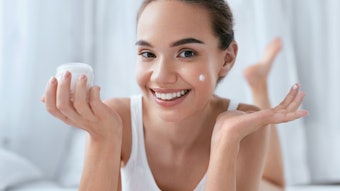
Post-inflammatory Hyperpigmentation (PIH) is a skin disorder that appears as tan, brown or purple tone in skin after damage, irritation or trauma. It can result in the over-production of melanin or irregular dispersion of pigment after cutaneous inflammation.
Featured: The Bright Side—Formulating Lighteners to Protect and Maintain Skin Health
When this occurs in the epidermis, the production of melanin that surrounds the keratinocytes is increased, which is believed to stimulate mediators and reactive oxygen species that are known actors in the inflammatory process.
In some cases, PIH can affect the dermis due to inflammation-induced damage to basal keratinocytes. This, in turn, releases an excess of melanin; this type of PIH will often present as a blue-gray appearance to the skin.1 Instances of skin conditions that can result in PIH include psoriasis, infection, allergic reaction, atopic dermatitis, burns and acne.
PIH has been identified as more chronic in individuals having Fitzpatrick skin types III-VI,2 which already produce significantly more melanin than types I-II. Even with proper treatment, it can take six months to a year to see full improvements in skin with PIH.3
PIH can be treated using a variety of ingredients and product forms, and an assortment of prescription, OTC drug and cosmetic ingredients is available to assist in the treatment of this condition. These ingredients can cause photosensitivity, however, so it is important to combine the use of these ingredients with sunscreen, to reduce adverse effects.
Popular product forms to improve PIH include toners, essence, serums, creams and lotions. For the purpose of this article, I will be focusing on serums.
Thickeners
To create the serum-like product texture, water-based thickeners are ideal to emulate a low viscosity, gel-like feel. Thickeners in a serum will function by controlling the rheology, flow and texture for the formulation. These also help to maintain the homogenous distribution of any insoluble ingredients and stabilize the formula.
Synthetic polymers such as acrylic acid and carbomers can be used. These molecules create crystal clear gels and provide a water-like feel. Gums such as guar gum, xanthan gum and carrageenan are also great options to create a texture that has added slip and a slightly sticky residue in formulations.
Cellulose is, likewise, a wonderful option to add slip to the formulation; some examples would be hydroxyethyl cellulose and hydroxypropyl cellulose. It is important to note the gum and cellulose are best when wetted with glycerin or propanediol before adding to water, to minimize clumping.
Whitening, Lightening and Brightening Agents
In order to reduce the excess of melanin production that causes PIH, specific ingredients are often utilized to target tyrosinase. Tyrosinase is the main enzyme promoting melanin production through melanogenesis. Melanogenesis is a complex pathway involving a combination of enzymatic and chemical catalyzed reactions. From this, as noted, researchers have developed ingredients to target and inhibit and/or reduce tyrosinase activity.4
Featured: Fruitful Skin Benefits: Litchi Peel Extract for Natural Brightening
Hydroquinone is one agent that works to inhibit the tyrosinase enzyme. In the U.S., hydroquinone is only available over the counter up to 2%, whereas prescriptions are available through a physician at 2-4%. This ingredient has been found to work effectively after 4-5 months of use. Based on its mechanism of action, it should not be used by pregnant women. Retinoic acid is another skin brightening agent that can only be prescribed by a physician at 0.025-0.100%. Azelaic acid is yet another that inhibits melanin production and is also well-known to treat acne.
Alpha hydroxy acids (AHAs) can be used to help not only with increasing cell turnover, but also as a penetration enhancer for other ingredients such as hydroquinone, to help increase the efficacy of the formulation. Examples of AHAs include glycolic acid and lactic acid. Other functional ingredients reported to reduce tyrosinase production are licorice extract, kojic acid, arbutin, niacinamide and beta-resorcinol; these ingredients do not require a prescription but have been found to help PIH.
While many of these ingredients work well to treat PIH, when formulated, their concentrations must be taken into account as many are known to cause photosensitivity, dermatitis, itch and skin thinning. Performing clinical studies on the final formulation will be vital to ensure product safety and efficacy.
Humectants
Humectants are generally hygroscopic substances that help to add water content to the top layer of skin by facilitating hydration. Humectants are compounds that attract and bind to water. They also help to make up the Natural Moisturizing Factor (NMF).
Previously: 6 Reasons to Embrace High-humectant Formulas: Free Webcast
Humectants can not only deliver hydration, but also help to enhance the skin penetration of brightening agents. As briefly stated, AHAs also are found to do this and function by promoting desquamation and improving barrier function with the increase of ceramide levels. Urea functions similar to AHAs but it also helps to decrease some of the side effects brightening agents can cause, such as itching and atopic dermatitis.5 Glycerin and propanediol, also previously mentioned, can help to deliver some thickeners into the formulation but these ingredients additionally function as humectants in the skin, therefore providing dual functionality.
Other ingredients reported to help increase hydration and divert some of the side effects that come with brightening agents include honey, propylene glycol, sorbitol and hyaluronic acid.
Preservatives
A preservative is a vital ingredient in any cosmetic formulation to help prevent the growth of yeast, mold and bacteria. Some examples that can be used in water-based serums are caprylhydroxamic acid, 1,2-hexanediol, phenoxyethanol and ethylhexylglycerin.
Related: ‘Preservative-Free’dom: Isopentyldiol as an Auxiliary Antimicrobial*
Conclusion
A variety of options is available to formulate serums to address PIH. It also is important to consider the end user of the product. Furthermore, performing clinical studies to ensure that the final formulation does not cause excessive skin sensitivity is crucial.
Each type of brightening agent has a different rate of efficacy and may cause skin sensitivity. Thus, it is not only important to prioritize the brightening agent used, but also the ingredients that maintain the skin barrier, such as humectants.
References
- Davis, E.C. and Callender, V.D. (2010, Jul). Postinflammatory hyperpigmentation. J Clin Aesthet Dermatol 3(7) 20-31. https://www.ncbi.nlm.nih.gov/pmc/articles/PMC2921758/
- Lucas, C. Dermatology education: Post-inflammatory hyperpigmentation (PIH). Skin of Color Society (SOCS). https://skinofcolorsociety.org/dermatology-education/post-inflammatory-hyperpigmentation-pih/
- How to fade dark spots in skin of color. Amer Acad Dermatol Assoc. Available at: https://www.aad.org/public/everyday-care/skin-care-secrets/routine/fade-dark-spots
- Pillaiyar, T., Manickam, M. and Namasivayam, V. (2017). Skin whitening agents: Medicinal chemistry perspective of tyrosinase inhibitors. J Enzyme Inhib Med Chem 32(1) 403-425. https://www.ncbi.nlm.nih.gov/pmc/articles/PMC6010116/
- Harwood, A., Nassereddin, A. and Krishnamurthy, K. (2020, Jun 2). Moisturizers. StatPearls. https://www.ncbi.nlm.nih.gov/books/NBK545171/










